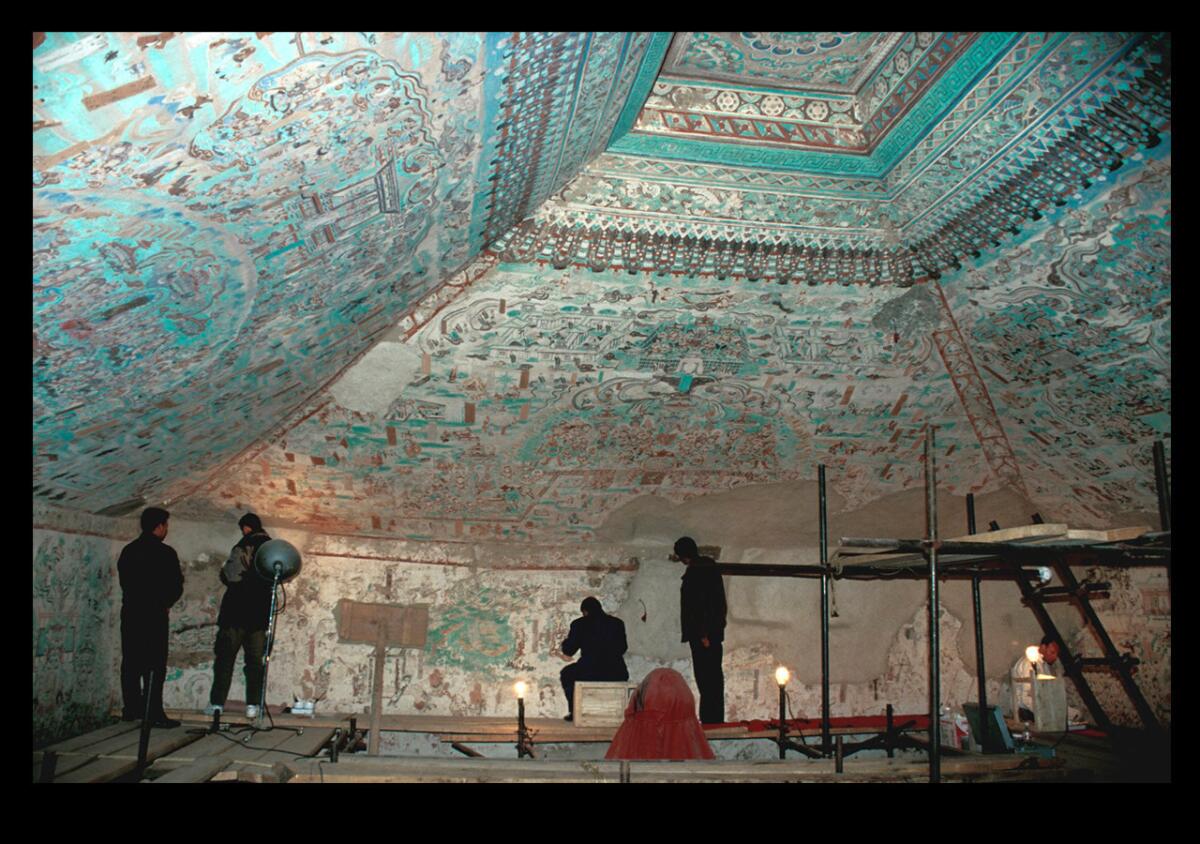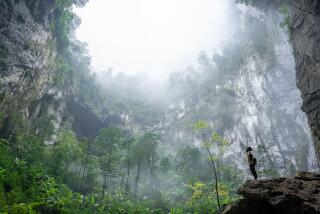Getty Institute helps save Chinaâs Mogao Grottoes from tourismâs impact

DUNHUANG, China â Hewn by hand out of a cliff face in the Gobi Desert starting about 1,700 years ago, Chinaâs most spectacular cache of Buddhist caves has endured countless assaults over the centuries â earthquakes and floods, plundering foreign explorers and even Russian soldiers, who billeted here in the 1920s on the run from the Bolsheviks and filled their beautifully painted quarters with smoky cooking fires.
Quite miraculously, nearly 500 caves at Mogao Grottoes decorated by merit-seeking monks, merchants and mandarins between the 4th and 14th centuries have survived until the modern era. But the 21st century has brought a new source of peril to this once-remote natural trove of Silk Road culture 1,200 miles west of Beijing: modern tourists.
Toting bulky backpacks, exhaling humid breath and posing other problems, these unwitting vectors of decay are arriving in ever-greater numbers each year and threatening to undermine decades of painstaking conservation efforts. Mogao, which received 26,000 visitors in 1979, its first year open to the public, is bracing for up to 1 million this year.
Yet thanks to some far-sighted planning by Chinese experts at the Dunhuang Academy, the researchers charged with preserving the caves, and their longtime partners at the L.A.-based Getty Conservation Institute (which has been working at Mogao since the late 1980s), the siteâs treasures are getting a fresh shot at survival â and even greater international exposure.
A $50-million visitor center opened this month, its futuristic form resembling the undulating sand dunes of the surrounding landscape. The complex, designed by Beijing architect Cui Kai, houses two state-of-the art theaters presenting films that aim to increase visitorsâ understanding of the grottoes while reducing the actual time they spend in them.
The vast majority of visitors are domestic tourists, so to introduce the splendor of the grottoes to a wider international audience, the Getty Museum in L.A. will host a major exhibition on the complex starting in May 2016. The exhibition will include several large cave replicas on exhibit at Mogao along with numerous relics, re-created paintings and a presentation on the cave preservation efforts.
The caves are also famed for housing an extensive library of Buddhist manuscripts, sutras and secular records in languages including Chinese, Tibetan, Uighur and Khotanese, though many thousands of documents were purchased by foreign explorers and academics and shipped to Europe, the U.S. and elsewhere in the early 20th century.
Tim Whalen, director of the Getty Conservation Institute, said curators have requested loans of items from the British Museum, the British Library and other European institutions that house many artifacts removed from Mogao in the early 20th century by academics and explorers.
Since the Getty Conservation Instituteâs founding in 1985, its researchers have worked on many high-profile World Heritage Sites, including the Tomb of Queen Nefertari and the Great Sphinx in Egypt. But the 25-year partnership with Dunhuang Academy is the institutionâs longest-running project, and its efforts in China represent âsome of the best work weâve ever done in the field,â said Whalen.
The Getty began with efforts to survey and scientifically understand the material composition of the grotto paintings and the myriad threats to their survival â from sand intrusion to high humidity levels.
Neville Agnew, principal project specialist for the efforts, has made more than 50 trips to Dunhuang since the late 1980s. When he first started visiting, the area was still quite isolated, he said; flights were irregular, and the area lacked a modern airport. But Chinaâs economic boom was starting, creating a middle class with disposable income.
âYou didnât need to stretch your imagination much to see what might happen in the future â all you had to do was look at the crowds at the Forbidden City in Beijing to see the direction things were going,â Agnew said.
At Mogao, the team developed a comprehensive conservation and conditions monitoring program that was implemented over the last decade in Cave No. 85, as a sort of demonstration project.
Orchestrated by filling in black-and-red line drawings with bright mineral pigments, the paintings in Cave 85 and the rest of the grotto complex are a rich trove of Buddhist art, illustrating sutras, parables and myriad other aspects of the religion. But their significance extends far beyond that, for the illustrations are important sources of historical information about such topics as clothing, dance, musical instruments, wrestling, polo, archery and apparently some sport known as âelephant lifting.â
The caves also contain many religious sculptures, including one massive, 1,300-year-old Buddha draped in orange robes that extends more than 100 feet high and nearly 40 feet wide, with toes the size of a manâs torso.
But thinking beyond the cave level was also needed. Starting in the late 1990s, Getty specialists along with Chinese government cultural heritage authorities and the Australian Department of the Environment and Heritage worked to establish the China Principles â national guidelines for cultural heritage conservation and management. In a country with vast numbers of historic sites but an often hodgepodge and unscientific approach to preservation, such parameters filled a critical void.
Back at Mogao, the team got to work crunching numbers on just how many sightseers the cave complex might be able to accommodate. The factors are complex â for example, all the caves have been fitted with doors, and on hot days, opening them to let in sightseers can quickly elevate humidity levels that can damage paintings. In addition, too many visitors in a cave can lead to high concentrations of carbon dioxide, which might prove hazardous to visitors, particularly the elderly, Agnew said.
âYou can go in, reattach some paint flakes and go home, but thatâs really not particularly useful,â said Whalen, who visited Dunhuang this month for the official opening of the new center. âYou need to look at this in a much larger sense.... These are questions facing World Heritage Sites everywhere â how do you preserve them and still ensure access for the public and scholars? But there are not a lot of organizations investing in research that finds answers to these questions.â
According to Wang Xudong, deputy director of the Dunhuang Academy, the research with Getty on visitor capacity indicated that as it was, the Mogao site could handle just 3,000 tourists per day â a number that seemed unrealistically low given the growing interest in the grottoes. At the same time, he said, the Dunhuang Academy wanted to digitize Mogaoâs 480,000 square feet of paintings for research and exhibition purposes.
The idea for the new visitors center and film presentations was hatched with the aim of addressing both needs.
Although the Getty Institute had no direct involvement in constructing the new film center â funded 70% by the central government, with the rest coming from provincial, local and private sources â Wang said its research was a key factor in pushing the project forward.
Once inside the sweeping new structure, viewers see two films lasting about 20 minutes each. One Imax-like movie introduces the history of Dunhuang and the Silk Road, while the other â projected on a domed, almost planetarium-like screen â immerses visitors in the cave interiors, soaring over scenes of concerts, village life and dancing angel-like apsaras (spirits) trailing luxurious ribbons of cloth.
The films were directed by Chen Jianjun, a Chinese documentary maker. The painstaking process of photographing seven caves in high resolution almost inch by inch took seven months, followed by more than two years of editing and post-production.
Sightseers must now start their visit at the film center and then are bused to the actual grottoes. In addition to visiting eight to 10 caves, they can tour an existing museum and other exhibit spaces housing artifacts including sculptures, textiles and handwritten scrolls, and life-size replicas of several of the caves. The number of visitors to Mogao is now capped at 6,000 per day and reservations are required.
So far, 93 caves have had their paintings scanned and digitized, Wang said, though only seven films have been made for visitors, because the cost is so high.
Unfortunately, said Wang, technical challenges of projecting the films means they wonât be included in the Getty Museum exhibition. However, the Dunhuang Academy hopes the idea can be applied at other cultural heritage sites. âIdeally these methods can be adapted at other sites, both in China and elsewhere in the world,â said Wang.
Nicole Liu and Tommy Yang in The Timesâ Beijing Bureau contributed to this report.
More to Read
The biggest entertainment stories
Get our big stories about Hollywood, film, television, music, arts, culture and more right in your inbox as soon as they publish.
You may occasionally receive promotional content from the Los Angeles Times.











